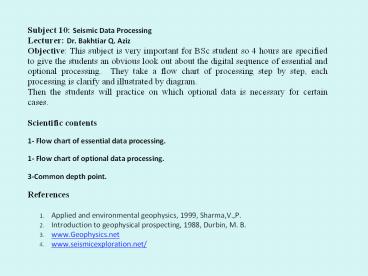Geophysics - PowerPoint PPT Presentation
1 / 13
Title:
Geophysics
Description:
Digital processing of seismic data It is a sequence of operations carried out according to a predefined program to extract a useful information from a set of raw data. – PowerPoint PPT presentation
Number of Views:47
Avg rating:3.0/5.0
Title: Geophysics
1
(No Transcript)
2
Digital processing of seismic data It is a
sequence of operations carried out according to a
predefined program to extract a useful
information from a set of raw data. It is
summarized as follow 1- Data copying. 2- data
classification and storage. 3- Many types of
computation and analysis. 4- Display of
results. Display of raw data There are four
types of displaying seismic data on paper 1-
Wiggles 2- Variable area 3- WiggleVariable
area 4-Variable intensity
3
Distance (Trace)
Seismic section display as WiggleVariable area
0
1
TWO Way Time
2
4
Data processing Sequence It is divide into two
parts 1- Essential Processing. 2- Optional
Processing.
Optional Processing.
5
1-Essential Processing
True Amplitude Recovery (TAR) Involves the
removal of the following effects by multiplying
the trace with the (F(T)Tar). 1- Spherical
divergence. 2- Inelastic attenuation. 3- The net
gain imposed by the recording station.
Scaling constant
Average velocity
Gain applied
Absorption coefficient
Data Editing Some seismic data is harmful on the
seismic record, so they have to be removed Such
as 1- Weak data 2- Dead data 3- Reverse data
6
Muting on actual seismic section
Dead or bad traces
Bad data removed
7
Common depth point (CDP) or Common reflection
point (CRP) It is a group of wave path have one
common depth point In the past single shoot point
and geophone is used, so every point below the
surface is covered once.
In this case fold of coverage 100 or
100 Fold It is number of reflections from one
common depth. One fold of coverage may give wrong
result. So the fold of coverage is increased to
300, 600, 1200, 2400,
4800, 9600
6-Fold
12-Fold
24-Fold
48-Fold
96-Fold
3-Fold
8
SP2
SP4
SP5
SP3
SP3
SP6
G3
G1
G6
G5
SP2
G1
G2
SP1
SP1
G2
G3
G4
CDP
CDP
3-Fold, or 300, or
6-Fold, or 600, or
Concept of (CDP) stack It is a process of adding
all the seismic traces which return to one common
depth, it is always applied after static and
dynamic corrections.
After Stack
After NMO Correction
Before NMO Correction
9
The importance of CDP-Stack 1-Enhancement of the
signal 2- Attenuate the random noise 3- Control
the multiples
10
CDP-Gather After missing all unwanted data, all
traces that return to one common depth point are
gathered together to examine the process of data
editing
1 2 3 4 5 6
1 3 6
S
S
S
S
1
2
6
S
5
S
3
4
CDP
Data Editing
CDP-Gather
Muting It is a kind of data editing by which the
non-reflection events are removed, such as 1-
First part of traces which contained usually
refracted data, it is also called (first break
suppression). 2- directed waves.
Muting
Direct and Refracted events
11
2-Optional processing Deconvolution It is
similar to TAR , but here we compensate for the
loss of frequency components. This loss is caused
by the effect of the earth materials that act as
a filter for high Frequency. Deconvolution also
defined as a process by which we restore the
observed reflection Signal to the original form.
Trace equalazation It is a process involves the
adjacent of the gain of various channels so that
their Amplitudes are comparable.
12
G1 G2 G3 G4 G5 G6 G7 G8
G1 G2 G3 G4 G5 G6 G7 G8
Before Equalization
After Equalization
Migration It is a process that restore the
reflettion events to their proper position, it is
applied In the following cases 1- When the dip
is large. 2- When there is a syncline.
Before migration
After migration
Bow-Tie feature
13
Coherency It is a process by which a coherent
events (Reflection signal) are enhanced and
incoherent events (Wind noise) are attenuated.
Before Coherency
After Coherency































